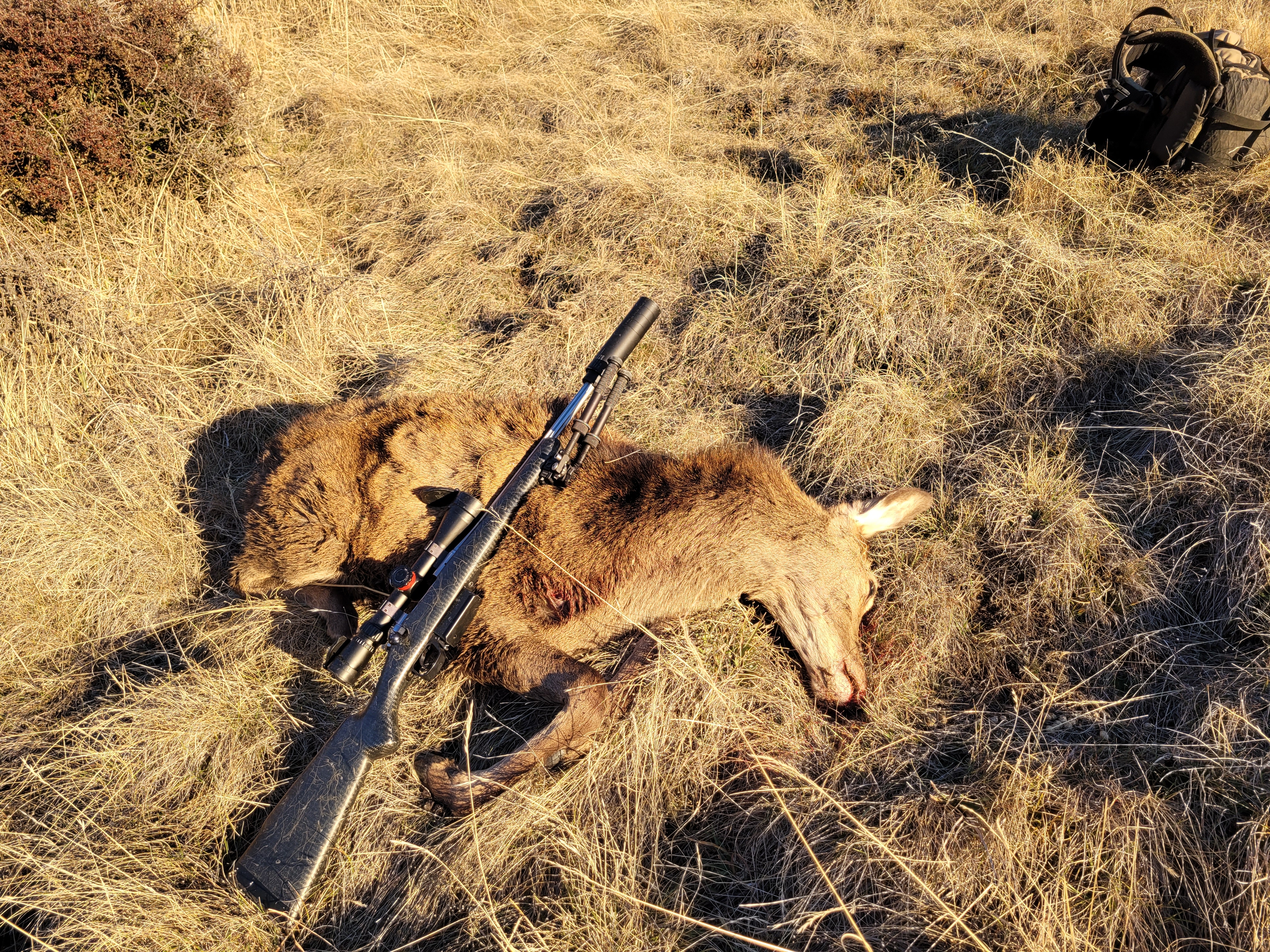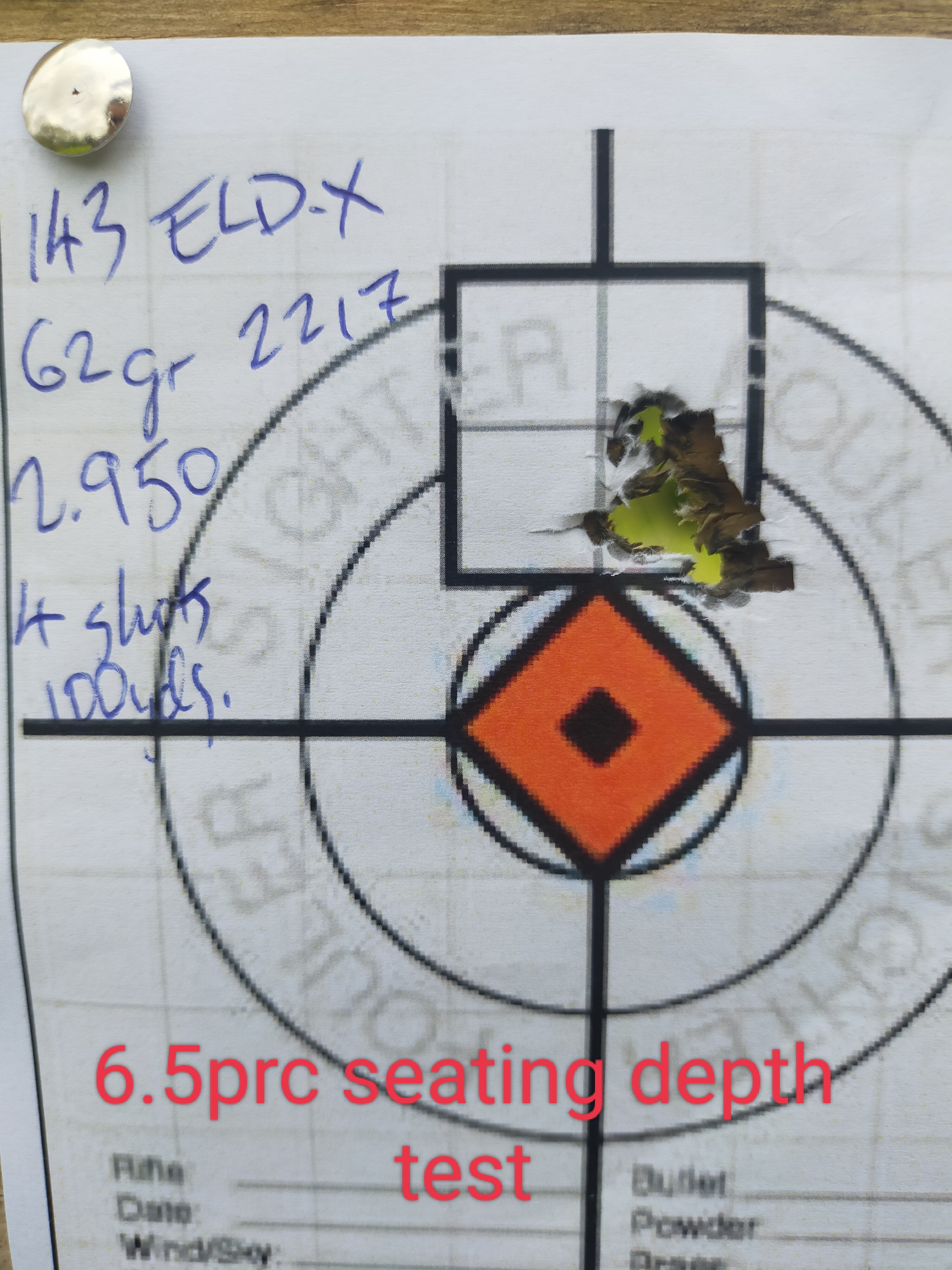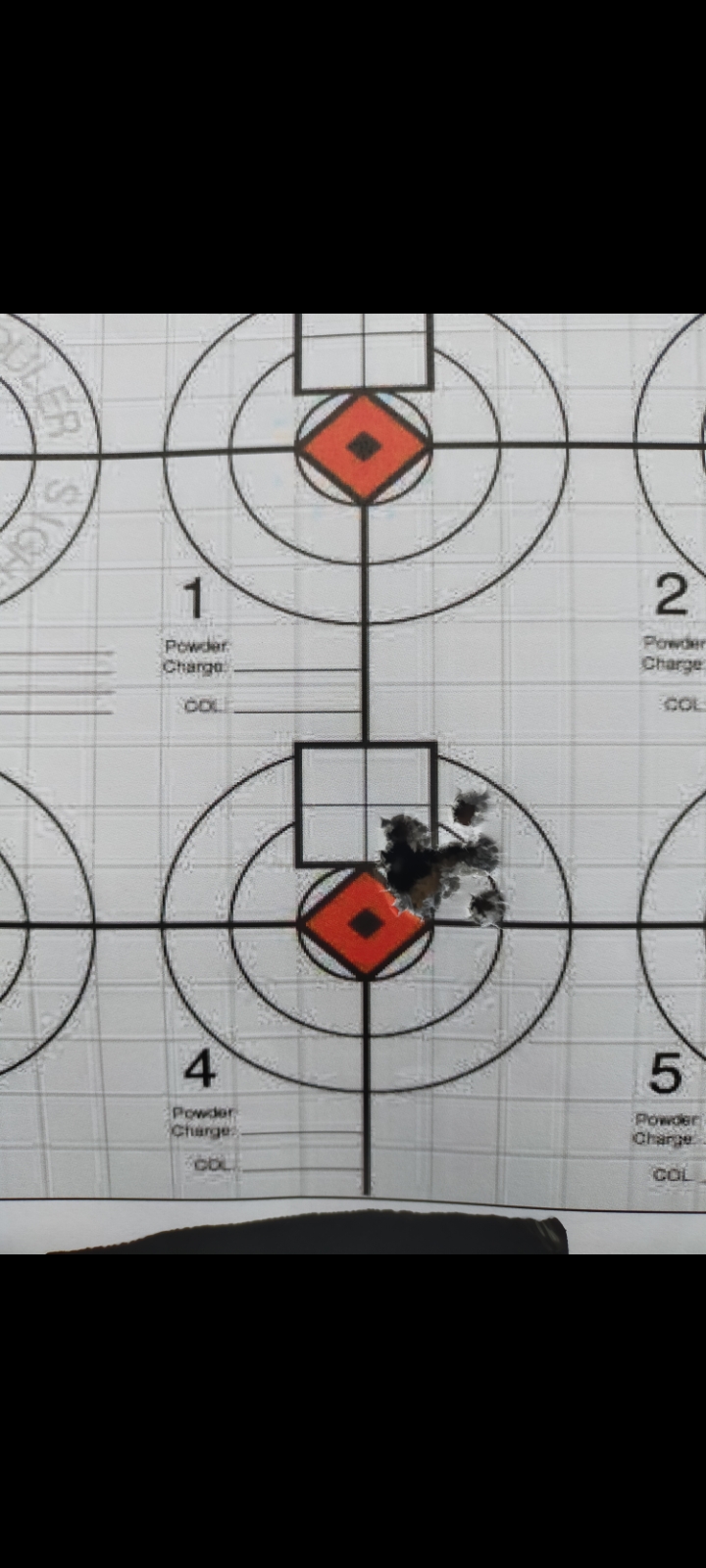Here's my seating depth test from the weekend
Welcome guest, is this your first visit? Create Account now to join.
Welcome to the NZ Hunting and Shooting Forums.
Search Forums
User Tag List
+ Reply to Thread
Results 16 to 30 of 45
-
15-07-2024, 07:58 PM #16
-
-
15-07-2024, 08:04 PM #17
Please do some testing for yourself. I'm intrigued to see the results. I only have limited rifles with which to gather and share data, and any findings such as the .260 powder charge test can only be treated as a case study relevant only to that rifle, powder, bullet, brass etc, until a much larger body of data is available to look at for trends.
-
15-07-2024, 08:11 PM #18
Benchrest shooters are insanely obsessed with the idea that tweaking the tiniest aspect of the load (tuning) will produce the best precision for the conditions, going so far as to "tune" during matches by changing the load during relays.
I have not seen any convincing evidence that the "tuning" aspect is anything more than a sport entirely consisting of confirmation bias, playing in the noise, and the results are essentially random as far as the tuning - the winners are the best shooters with the best built guns.
That's my working theory but I'd love to see some meaningful data. That whole thread is nonsense speculation and theory. Just go shoot some 30 round groups with a tuned vs slightly "out of tune" load and prove the difference. It isn't a hard test.
The next question, if there was a difference, would be - can it be resolved and is it practically significant for any particular use? And is it worth trying to identify when the process to genuinely identify it is impractical.
-
15-07-2024, 08:19 PM #19Member

- Join Date
- Jul 2012
- Location
- Tauranga
- Posts
- 2,637
Hope the time in the hills was productive Gimp,( edit oh I see it was ) shame Keith had to end up doing the testing at 100 Yds. I would like to have seen it done farther out. He always has great content to make you think.
I admire anyone that can spend the time and components to go into things, as deeply as he does and share it.
-
15-07-2024, 08:28 PM #20
I want to add something into this discussion.
I don’t like admitting it , but I’m probably the biggest dispersion factor when it comes to testing a favoured load .
I have good days on the Trigger and not so good days .
I’ve been playing with a couple of different projectiles in my 6x45 over the last couple of days .
After shooting numerous 10 shot groups ( yes I have been converted from my old 3 and 5 shot group testing) I can’t hand on heart say that I didn’t have an effect on the results.
If I could say that I triggered the shot perfectly every single time then I probably wouldn’t be commenting on a thread on a shooting forum.
I’d instead be composing my acceptance speech for winning some world championship somewhere.
The testing we all do isn’t in some test tunnel with a machine rest to eliminate the shooter influence , in my case it’s laying out in my paddock with bugs crawling on me and thoughts of work / family / what I have do later etc etc .
I’ve got my Rifle / Load combo down to 14mm - 17mm at 100m for 10 shot groups .
A couple of millimetres in my hold / technique can have a much greater effect on the results compared to - should I load 25.7gr or 25.9gr
Conversations like this assume that everyone is a World class Trigger man , well sorry to be the bringer of bad news chances are that you aren’t.
I’ve listened to a multitude of the Hornady podcasts now on this and similar subjects and something that I’ve yet to hear mentioned is shooter ability and consistent repeatability .
I’ve decided to dedicate as much time working on me , as I have in the past on my reloads .
I think back on some of my previous results and really question “ was it me or the load “ .
Now a bad projectile/powder type/powder weight/OAL etc will just be Dogshit , but it’s those fine tuning of a decidedly good load that I’m talking aboutFALL IN LOVE WITH THE NUMBERS , NOT THE IDEA
-
15-07-2024, 08:48 PM #21Member

- Join Date
- Jul 2012
- Location
- Invervegas
- Posts
- 5,663
Shooting 22s at 50M provides quite an education on one's "technique". With a light 22 it's quite possible to work quite nice groups right round a bull or other aiming point using nothing more that variations on hold etc. Having said that I'm not a fan of "called fliers" , I think this is most often just another manifestation of cognitive bias, and a particularly damaging one at that.
-
15-07-2024, 09:54 PM #22
Ok to get my load, a fella told me his load so I decided to work up slowly.
I loaded up 6 rounds, 3 62gr SP's 450 cci primers, 25gr 2206H in Hornady brass and the other 3 rounds were 25.5gr 2206H.
The 3 rounds of 25.5gr produced .4 moa job done and 30 deer later still going strong. Total 6 rounds to get my load.
Shots on deer ranged between 100 and 350 meters in all conditions so I'm happy I have a great load, 2 other loads were achieved with no more than 20 rounds in total for .5 moa.
Bullet seating was duplicated from factory Hornady whitetail 60gr which shot well.
Enjoying going hunting, Happy days!When hunting think safety first
-
15-07-2024, 10:01 PM #23Member

- Join Date
- Jun 2019
- Location
- Manawatu
- Posts
- 1,217
I think that a seating depth test is pointless if you already had the best seating depth to start with.
This is 4 shots at the start of a seating depth test after I had decided on a charge weight. I decided I didn't need to test any other lengths because, well look at it

This next photo is from another pressure ladder test with the same rifle and Lapua brass (Norma used in the above). 12 different charge weights, same coal as the previous established load.

I got lucky that I chose to run with the coal that Hornady recommended for this combo. Same powder used in both tests and same charge weight was settled after further testing.
-
16-07-2024, 01:53 PM #24Member

- Join Date
- Nov 2012
- Location
- NI
- Posts
- 1,736
Thanks for the response. Iíll just take your word for it based on all the data youíve shown. Appreciate you taking the time to explain it.
My usual reloading always seems to get decent SDs.
This time round new Sako brass, die button pushed through neck to uniform.
Debur primer pockets and necks
Fancy scales for powder (0.02 gr)
Brush necks with over sized nylon brush.
All rounds off press checked for BTO.
-
17-07-2024, 04:05 PM #25Walking my rifle

- Join Date
- Dec 2015
- Location
- Hamilton
- Posts
- 1,334
Its a waste of time most of the time for most people (especially hunters).
However it is needed at times, for me the only bullets' that I've ever really needed to do it on was the berger vld's
most of the time pick a number say 1mm or 0.5mm jump and roll with it, if your rifle is setup properly, good bedding etc. it will be just fine even for long range shooting, i used to shoot my 6.5cm out to 1600m and i never needed to adjust the jump except to maintain velocity for throat erosion.
but with the bullets that need it, it really works wondersIf you can't kill it with bullets, dont f*ck with it.
-
17-07-2024, 05:30 PM #26Member

- Join Date
- Oct 2022
- Location
- Pukekohe
- Posts
- 1,172
I never mucked around with it greatly but differences apply between cup 'n core and mono metal bullets. Most if the time monos perform seated for a bigger jump than c&c.
I found a lot of c&c bullets shot best from almost touching to not far off the lands. Only when distance to the lands became excessive did accuracy become erratic. But a few rifles didn't even mind that and still shot well enough for hunting. All rifles are individuals and their preferences have to be discovered. They must be female ...
-
19-07-2024, 09:04 AM #27Member

- Join Date
- Aug 2012
- Location
- Hastings
- Posts
- 719
Never been my thing to worry about seating depth. I go for mag length then make sure cartridges feed from the mag. Ammo loaded long can sometimes ride up and not enter the chamber so needs checking. Especially sharper projectiles like say eld ms. After that I just start in the middle with adi powder and work up until I get an ok group for hunting. Which for me is around 1/2 to 3/4 of an inch on average. Then the hardest thing to do is get up early and get into it!
-
20-07-2024, 05:12 PM #28Member

- Join Date
- May 2023
- Location
- New Zealand
- Posts
- 197
Well I'm going to go against what everyone above says about seating depth.
My "tuning" method is done with 3 shot groups, work up powder charge to see what the rifle likes, adjust seating depth (0.003") with the best powder charge and then fine tune powder and seating depth.
This works with "ACCURATE" rifles, I capitalised accurate for a reason, I wouldn't say this works consistently for factory rifles.
Gimp mentioned "Benchrest" shooters tuning during the match and being insanely obsessed, he is right and the ones that win aren't the ones that are the best shooters with the best built rifles.
If it was, the same people would win match after match and no one else would have a chance.
At a benchrest match all the rifles are built by some of the best "Benchrest" gunsmiths in the USA and all of these gunsmiths have built rifles that have won major shooting matches, while you need a good rifle you also need to be able to read the conditions and "TUNE" the rifle for the conditions to win.
With an accurate rifle firing 3 shot groups at 200 you can see the change in groups by changing the seating depth, I have seen groups go from 1" to 1/2" to 1/4" just by changing the seating depth and you can get this to consistently happen when you alter the seating depth or change the powder charge.
Tune is everything and easy to see with an accurate rifle, Greg who shoots Benchrest will confirm that.
Saying that the same tune isn't necessarily the right tune on two different days.
This is a very interesting video, Erik's videos are very interesting, and he is a successful shooter, his video with Speedy about his first Benchrest match is enlightening.
https://www.youtube.com/watch?v=r2iz3E_Wd1I
-
21-07-2024, 05:38 PM #29
How do you know the effects of "tune" that are being observed aren't just the random variation that absolutely is inherent and clearly observable between groups with small numbers of shots?
Someone wins a match by "tuning".
If everyone is doing it - what's the most significant contributor to score?
Is it average group size? (i.e. mean precision at that sample size - a function of rifle quality)
Is it shooter skill?
Is it tuning skill?
If everyone has good rifles - ok maybe that's equal.
If not the same person wins every time - ok maybe it isn't shooter skill or the rifle, if everyone has them built by the same guys from the same parts.
So.... why isn't everyone equal at tuning if they've got the same rifles and the same shooting skill ?
What evidence is there that the "tuning" is a larger or more significant effect and there's more difference in skill across the field that makes it the single thing that determines the winner?
Is it just whoever gets lucky with the sample that produces the most useful shots for score out of the population on the day? And the rifles are all good, the loads are more or less all the same, and the shooters have some skill but are probably very similar (this is my current theory, and the theory for which there is the most evidence)
Like I say - I have yet to see any meaningful evidence. My mind is open if someone produces some.
Unfortunately success in shooting doesn't necessarily mean any particular tranmittable insight - Erik is long on theory and short on data from what I have seen - also heavily invested in Selling You Things
-
21-07-2024, 05:43 PM #30
If someone is interested to know whether seating depth, within functional bounds, makes a measurable (ie actually meaningful in practice) difference in precision for their actual use, please just go test it with a sample size that actually has a chance of somewhat representing the population (at least 20rd), and with a metric that is meaningful (mean radius) and post your results. Can't argue with data that is collected sensibly.
Likewise, if you're already convinced that it does or doesn't matter - consider - how would I test to determine if it does or does not? Better to test, get data, and make a more informed decision on your process in future - may save components and hassle in the long term
Similar Threads
-
When to re optimize seating depth ?
By Bagheera in forum Reloading and BallisticsReplies: 7Last Post: 02-11-2018, 10:34 PM -
6.5x55 seating depth
By Sr5dan in forum Reloading and BallisticsReplies: 18Last Post: 09-10-2018, 11:04 PM -
Seating depth
By Jackangus in forum Reloading and BallisticsReplies: 7Last Post: 16-03-2015, 10:00 AM -
help with seating depth
By Dino in forum Reloading and BallisticsReplies: 10Last Post: 08-09-2013, 09:12 PM -
seating depth changes
By Neckshot in forum Reloading and BallisticsReplies: 3Last Post: 22-04-2013, 11:31 PM
Tags for this Thread
Welcome to NZ Hunting and Shooting Forums! We see you're new here, or arn't logged in. Create an account, and Login for full access including our FREE BUY and SELL section Register NOW!!





 53Likes
53Likes LinkBack URL
LinkBack URL About LinkBacks
About LinkBacks



 Reply With Quote
Reply With Quote



Bookmarks